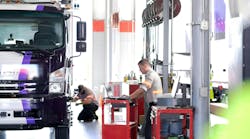By working together, shippers and carriers have a shot at eliminating the need for unwieldy regs
If I had to choose one area where our industry could benefit from increased efficiency, I would choose point of delivery and pickup - transportation's biggest time trap.
Several years ago, carriers began using communications systems that enabled them to pinpoint the position of a vehicle at any point in time. The ability to contact shippers and receivers prior to pickups and deliveries was heralded as a major step forward in customer service, as well as fleet utilization.
Most carriers can't put a specific economic value on the use of communications systems, but they'd be hard pressed to live without them.
Carriers have a number of bottlenecks in their systems over which they have varying degrees of control over costs. On the plus side, they maintain more rather than less control over costs related to equipment downtime, repair time, routing, and fuel scheduling.
At the other extreme are costs related to non-driving time. Apart from hook-and-drop operations, fleets remain at the mercy of dock personnel for timeliness in non-driving operations. And time is money.
A recent study conducted by the Refrigerated Division of the Truckload Carriers Assn. shows an increase in the time spent waiting to load and unload, as well as the actual time spent loading and unloading. This results in tremendous inefficiencies on the part of the carrier.
While one man's floor is another man's ceiling, the cost placed on the transportation system for these delays causes an increase in the amount of equipment required, which further exacerbates the driver shortage. A 6% increase in the number of loads handled each week could be achieved from only a 10% reduction in the time spent on non-driving activities. This would mean 6% fewer vehicles and drivers for the same amount of freight.
When drivers are used as cargo handlers, driver turnover and injury-related time off both increase. In addition, the cost of tying up equipment is passed along to all transportation recipients sooner or later.
There are some who feel that the current system will weed out the good from the bad - but it doesn't work that way. The supply of carriers will always outweigh demand. This is generally good for consumers and producers because it means that transportation costs are always facing downward pressure. The problems occur when carriers have to take shortcuts in order to survive. This, in turn, leads to situations that may catch the attention of government regulators - who have the power to place significant operating burdens on the entire industry.
We need to establish a formal set of good transportation practices that could be readily adopted by shippers, receivers, and carriers alike. It may seem naive to suggest that companies will add cost and/or procedures to their current operations in order to provide for an improved system of transportation overall. However, improved operations will attract competitors that want to deliver their freight, as well as assist in the improvement of overall distribution of their goods and services.
Our research indicates that very few shippers or receivers have corporate policies that set out to abuse drivers' time. For those that do, I would suggest that we make their activities public and show the extent to which they depend on our transportation system. Some have even suggested boycotting their products.
When overall corporate policy is intended to create a positive environment for suppliers and customers alike, management should be made aware of problems so they can determine whether adjustments can be made.
But the responsibility for smoother freight transitions does not lie with shippers and receivers alone. Carriers must also be willing to make changes. The fact of the matter is, we must all make adjustments if we want to keep stiff regulations off the books. Global mandates at the federal level will most likely make transportation much more expensive than would industry-supported cooperation among shippers, receivers, and carriers.


